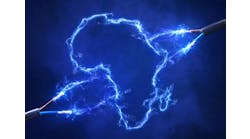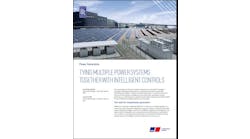Developers and technology companies worldwide continue to focus on electrifying energy-poor areas of Africa. Recent example: 40,000 residents and businesses in the northeast African country of Eritrea now have reliable electricity thanks to two new minigrids.
Developed by UK-based Solarcentury, the minigrids (Africa’s term for microgrids) combine solar PV, lithium-ion batteries and diesel generators. The projects — a 1.25-MW minigrid in Areza and the 1-MW minigrid in Maidma — replace small diesel generators, which were comparatively costly and polluting, unreliable and limited in hours of operation.
Local economic opportunities should increase by a significant margin as a result of the minigrids coming online, said Daniel Davies, Solarcentury Africa general manager.
“There are also many wider social benefits, including lighting for study, power for the health clinic and enhanced opportunities for small businesses,” he said.
Solarcentury’s involvement with the Eritrean rural minigrids projects began when it responded to an invitation for proposals issued by EuropeAid in 2016, said Davies. Solarcentury won the fixed-priced contract as the lowest-priced, qualifying bidder.
Less costly than extending grid
The project was finished on budget and cost less than extending the utility grid to the two towns, Davies said. Residents and businesses will pay for the mingrid power they consume. Smart meters have been installed to monitor and keep track of their consumption.
“As a model for rural electrification, this presents an alternative technical solution which takes advantage of low-cost solar and energy storage and will provide abundant power 24 hours a day, seven days a week,” he said.
Canadian Solar supplied the solar PV modules for the minigrids and SMA the PV inverters. Tesla supplied and supported installation of the energy storage and associated power electronics, and Caterpillar the diesel gen-sets.
“We are technology-agnostic and will choose the best technology for the project. Using second-rate materials in a harsh environment where the cost of replacements and repairs will be high is a common mistake, and we sought to avoid this to ensure reliable operation. The client had also specified that it wanted Tier 1 suppliers — which is in line with our supply strategy— so we selected suppliers who had the ability to support the project as well as providing the right materials at a competitive price,” Davies said in an interview.
“Environmentally, the system is expected to deliver power which is 70-80 percent solar — the balance coming from the new back-up generators,” he said. “When the generators run they will be optimally loaded by using the batteries so that fuel use will be minimized. This is an improvement of the previous solution which was 100 percent diesel-powered. Obviously the performance and impact of the system can only be determined after some time — as people adapt to having a continually available power supply.”
Local economic opportunities should increase by a significant margin as a result of the minigrids coming online, according to Davies. “There are also many wider social benefits, including lighting for study, power for the health clinic and enhanced opportunities for small businesses,” he said.
Model for future minigrids in Africa
Solarcentury provided extensive training in minigrid operations and maintenance to employees of the Eritrean Electricity (EEC), which will operate and maintain the minigrids going forward. The London, U.K.-based project developer “will also provide after-sales support both on-site and remotely from our Nairobi O&M service hub along with support from colleagues in London who oversee our remote monitoring platforms. The cost of the training and after-sales service is part of the original contract, and going forward this will be an operational cost for the EEC,” Davies said.
Funding for the project was provided by the Eritrean government with support from the European Union Delegation to the State of Eritrea and the U.N. Development Programme. “The Eritrean project presents a model for rural electrification, and Solarcentury is in discussions about similar projects across Africa,” said Tesfai Ghebrehiwet, director of renewable energy for Eritrea’s Ministry of Energy and Mines.
Who’s the grand prize winner of the 2019 Microgrid for the Greater Good Award? Join us at Microgrid 2019 for the announcement!
The rural minigrids project is Solarcentury’s first in Eritrea, but it has been active in Africa for six years and has completed projects in Kenya, Nigeria and South Africa, including delivering a hybrid minigrid for the Theobroma Group’s Tulip cocoa processing plant in Nigeria. It has also been contracted to deploy a minigrid system that plugs into on site hydro power and diesel generators for Unilever’s tea farm and processing facility in Kenya. The company also expects to start work on its first project in Ghana very soon, according to Davies.
“We are focused on delivering hybrid power solutions for businesses, and we also provide similar technical solutions for end-of-grid or off-grid locations, for example remote communities or mines. Increasingly we are also looking at larger utility-scale projects with solar and batteries to enhance grid stability, reduce power costs and increase capacity,” Davies said.
Track news about minigrids in Africa. Subscribe to the free Microgrid Knowledge newsletter.







